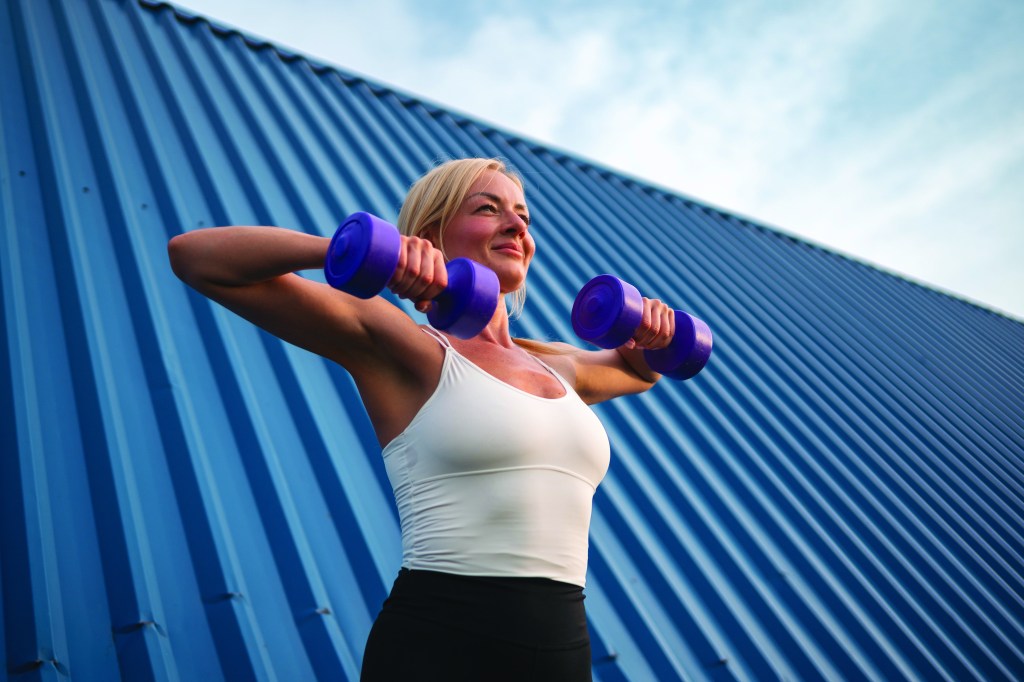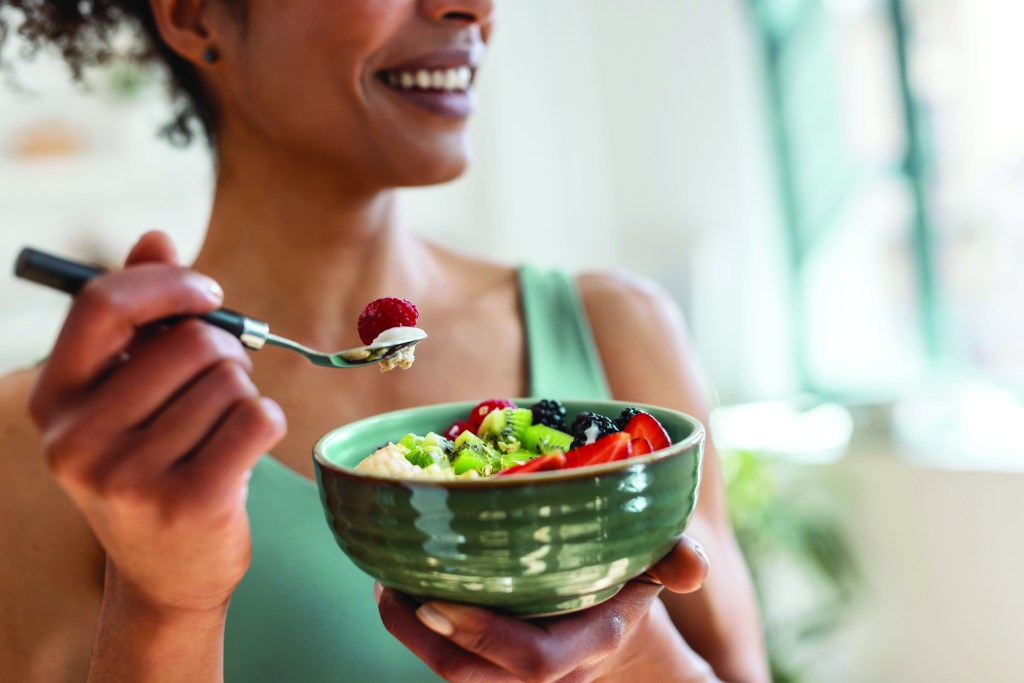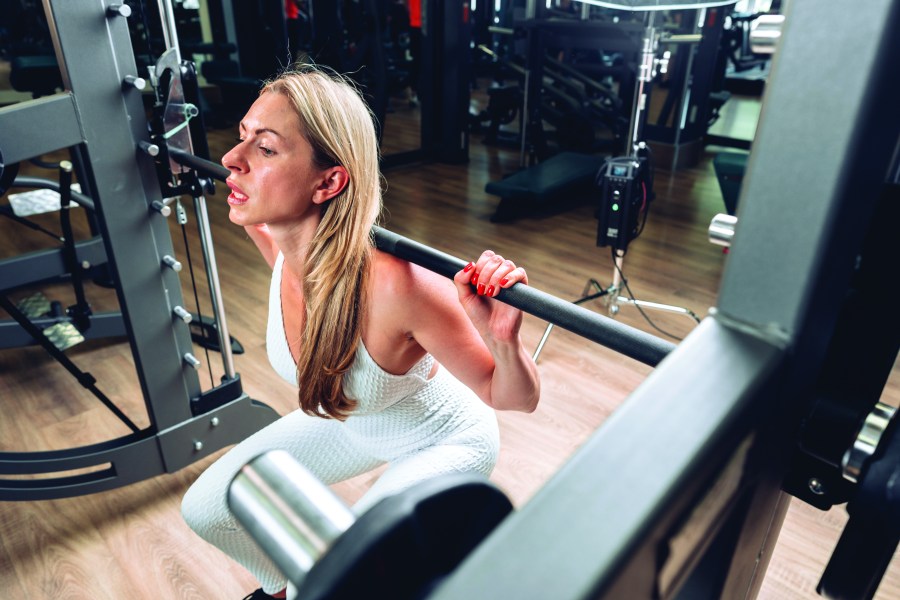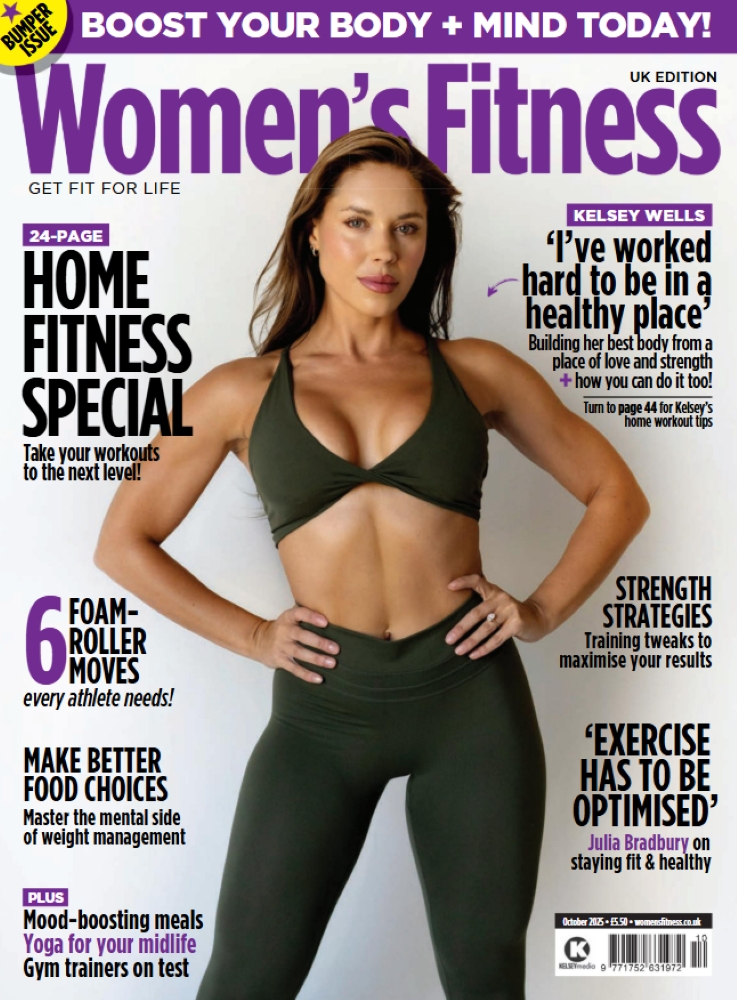Want to navigate the perimenopause with energy, vigour and body confidence? Picking up heavier weights might be the answer…
Words: Natalie Shanahan
Most of us know that menopause fitness is a hot topic. For too long, women’s health has been under-researched, misunderstood and dismissed – but times are changing. This previously taboo subject is now on the agenda, and awareness is key to helping you understand what is happening and how to navigate what can be a challenging time.
Perimenopause describes the transition period leading up to the menopause. The accepted wisdom is that it starts during a woman’s mid-40s, but it can begin earlier. In fact, a 2025 study of 4,400 women age 30-plus from health provider UVA Health’s Health & the Flo tracker app reports more than half of women aged 30-to-35, and nearly two-thirds of those aged 36-40, experience moderate to severe symptoms associated with the menopause.
Spot the signs
So, how do you know if this is you? Typical symptoms of the menopause include hot flushes, brain fog, poor sleep and even bladder leaks. Whilst there is medication available to help ease these symptoms, it’s now widely accepted that regular exercise and a healthy diet can help manage these issues – but what if you already eat healthily and exercise regularly, but symptoms are still rife?
You’re not alone: it’s estimated that 10 million people are currently members of a gym, so why do women who work out regularly and eat well still suffer with the fatigue and weight gain associated with this phase of life? The move-more, eat-less tactic that worked so well in their 20s, is now leaving them exhausted, as well as undernourished and thick around the middle. As hormones change in the peri-menopause, so must training methods, too.

‘Lifting weights that are heavy enough to fatigue the muscle after only 3-8 repetitions will build strength and increase metabolic rate’
Change your mindset
When it comes to exercising during the perimenopause, it’s important to understand the hormonal shifts. There are three main types of oestrogen: estrone (E1), estradiol (E2) and estriol (E3). E2 is the most common type in women of child-bearing age, E1 is the only oestrogen your body makes after menopause, and E3 is the main oestrogen in pregnancy. E2 is an anabolic hormone that’s essential for muscle growth and repair. As this hormone decreases during perimenopause, women find it increasingly harder to maintain lean, metabolically active muscle.
Of course, both men and women naturally lose muscle as they age – without maintenance, we lose about eight per cent each decade after age 30, but this decline accelerates during the perimenopause. With less muscle, women have less energy for training and burn fewer calories at rest, which can, in turn, result in the dreaded middle-aged spread.
This is why women who already exercise need to turn up the intensity when they hit the perimenopausal years. Lifting weights that are heavy enough to fatigue the muscle after only 3-8 repetitions will build strength and increase metabolic rate, even in the absence of E2. Unfortunately, there is still a general trend among women to lift lighter weights for higher repetitions out of fear of ‘bulking up’. This mindset must change because building muscle
is key, especially for women who are perimenopausal or menopausal.
Build your strength
Heavy lifting sends a signal to the brain to activate all the available muscle fibres possible in order to get the job done. This mind-muscle connection works on a neurological level to create a really strong contraction and produce explosive power. On a cellular level, it stimulates the production of mitochondria, the powerhouses of the cells. The more of these, the greater your resting metabolic rate and the less chance of that middle-aged spread.
Women should focus on compound (multi-muscle) exercises, as these use more than one muscle group at a time – squats, deadlifts, bench presses and rows are great examples. If you’ve never trained like this before, don’t rush in and pick up the heaviest weights in the gym. Learn the movements and make sure your body can perform them correctly before adding resistance. Consider seeing a qualified personal trainer who can coach you in proper technique and progressively overload your muscles safely.
Combine these intense workouts with adequate rest, good sleep and enough protein to really reap the benefits. For those women who fear they will end up looking like Arnie, you can rest assured, you won’t even come close! Testosterone, one of the main anabolic (muscle-building) hormones present in both men and women, is significantly lower in women than men.
To put that in perspective, men’s testosterone levels are around 200-1200ng/dl, compared to just 15-70ng/dl in women of reproductive age. Even men at the lower end of the range (200nd/dl) will still have more than twice the amount as a woman at the higher end of the women’s normal range (70nd/dl). This makes it incredibly hard for women of any age to gain muscle size, even when they want to!

‘HIIT can boost your VO2 max (how much oxygen you can use) by as much as 46 per cent’
Consider your cardio
Now, you may think it sounds counterintuitive to up the intensity when you are already feeling exhausted, but truly recovering is key to ensuring you will be ready to push to the max in each session. If you are battling through long endurance sessions several times a week, it may be worth lowering the duration on a couple of days and doing a shorter, but more intense, high-intensity interval training (HIIT) session.
This style of training can boost your VO2 max (how much oxygen you can use) by as much as 46 per cent, raise your power at lactate threshold, and significantly lower your resting heart rate. It also stimulates the body to increase your mitochondria content, allowing you to burn more fat for energy when you are not exercising. It’s as if your body knows it is going to need energy for these workouts and causes your liver and muscle cells to absorb glucose from your blood, storing it as glycogen ready to fuel your next session – a task previously performed by E2 during your reproductive years. This is an excellent way to balance blood sugar and improve insulin sensitivity, therefore improving cardiovascular and metabolic health for years to come.
Too many long-to-medium intensity workouts not only cause extreme fatigue but also result in increased levels of the stress hormone, cortisol. This hormone already increases during menopause and encourages the body to store fat round the middle. To counter this effect, consider swapping one of these sessions for yoga, a walk in nature or a leisurely swim. These activities not only allow the muscles to fully recover between workouts, they can calm the sympathetic nervous system, a branch of the nervous system responsible for that stressful flight or fight feeling, doing wonders for your energy levels.

Yoga for perimenopause: ease anxiety, pain & insomnia
Eat for balance
Another important factor to consider is nutrition. There are so many conflicting nuggets of wisdom out there, it’s hard to know what is best. Like most things in life, the answer is nuanced: everyone is different and there is no one-size-fits-all answer. However, there are some non-negotiable points for active women:
- Eat a protein-rich meal before and after exercise
- Don’t cut carbs. Instead, choose nutrient-dense options from wholegrains, root vegetables, pulses and fruit
- Don’t go down the low-fat foods route; get plenty of omega 3- rich seafood, nuts and seeds
- Eat plenty of fibre from wholefood sources, and have a wide variety of fruit and vegetables at every meal
- Hydration is key: drink water before, during and after your session
There’s a host of other health benefits associated with strength training. These include stronger bones, younger-looking skin and improved cognition, plus it’s one of the most important things you can do to reduce the risk of neurodegenerative disorders as you age. Is it time you hit the weights room?
5 diet tweaks
- Eat more fibre. Recommendations are 25-30g a day, however, 50g or more show greater health outcomes
- Eat 2g protein per kilogram of body weight
- Consume at least 3,000mg DHA- and EPA-rich omega-3 foods per day
- Stay hydrated
- Reduce refined sugar and processed food
5 fitness tweaks
- Do 2-4 full-body strength sessions per week (aim for 4-6 reps to activate neuromuscular connections)
- Try HIIT and SIT (sprint interval training)
- Reduce endurance exercise
- Prioritise restful recovery
- Do 3 x 10-min multidirectional jump training to activate bone growth and prevent age-related bone loss.
Natalie Shanahan is a fitness and nutrition guru, with a BSc in Genetics and an MSc in Bioinformatics. Shanahan has helped optimise the lifestyles of hundreds of people, from athletes to the elderly. Her approach is unique: she blends her scientific expertise with a passion for practical application, transforming lives through one-on-one coaching and immersive fitness retreats around the world. She co-founded the 10-week Body and Mind program (bodyandmind.live) alongside psychologist Dr Helena Nundy. She also regularly hosts talks and workshops on health and wellbeing topics. Visit rnpt.co.uk and instagram.com/nataliernpt








